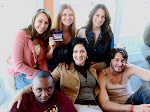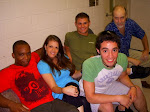PART 1: “STILL PHOTOGRAPHY”
The following series of articles document my experience on the Blank Stage Studios production of the short film NO EXPERIENCE NECESSARY, which was written & directed by Brent Brooks. These series of articles will go into detail on the different aspects of production in which I participated. As such this first article I will touch upon still photography and how I contributed to the film.
A little background on the short film NO EXPERIENCE NECEASSARY. Brent Brooks (whose previous film was the art house feature ART OF SUICIDE) developed the screenplay through the screenwriting group The Blank Page and decided to make this his first post-ART OF SUICIDE production (and the third film from the writer’s group to go before the camera). The plot is fairly simple as it depicts a serial killer who uses the deception of a casting call for a movie to lure his next prey. Nothing new in terms of writing but Brooks wanted to production a high production value production in which to use as a potential calling card for future work. This could be such a production.
I came on board as production manager (which I will discuss in a future article) because much of my experience in film production stems in this area. Although I did not intend to do any still photography on the film (since Brooks had already hired a photographer to do just this thing), I have the habit of doing this on my own accord mainly for my own archival purposes. I’ve learned through the years that many indie productions still do not see the benefit of having good production stills taken on set. I do this not only for myself but for all the other cast & crew as well. I freely give the pictures away and post most of them online so that everyone has access to them. This allows everyone to have a record of the production.
On the set of NO EXPERIENCE NECESSARY I took approximately 3,000 pictures over the course of 4 days. This is actually not as many as you might think considering that only about 500 of them are usable which includes both production stills of scenes in the film and behind the scenes pictures. The actually photographer on set didn’t take nearly as many as I did. There are several reasons for this the chief being that because I can put my camera on “silent mode” I can use it while we were filming whereas he could not. This allowed me to get numerous photos from all different angles. I was able to get the photos he could not.
This means that I got a lot of scene accurate photos which is good for the film in terms of representing actual scenes. I also paid a lot of attention in terms of getting a lot of behind the scenes pictures with cast and crew, not only in actual scene set up shots but also in group shots and in the obligatory “fun” shots.
The sheer amount of pictures that I took on the set of the film would not go unnoticed as when I started to post them online both cast & crew were finally able to see everything that happened in front of the camera as well as behind it.
Sometimes the importance of still photography is not recognized until it is too late to do anything about it. Indie films use still photography not only to craft and create movie posters but also to help with production stills for the film and marketing as well. A lot of the advertisement and marketing for an indie film can be seen online and nothing can sell a film to an audience better than a photo (unless of course you have a trailer already crafted).
Although I’ve got about 500 photos that represent the film, it was to Brooks’ idea to slowly reveal them to both the cast & crew and the public in order to help promote the film through production and into the film’s future which I now believe was only one of the most ingenious ideas he’s had to market and promote the film and in really that’s exactly what still photography is intended to do.
TO BE CONTINUED.
Friday, February 5, 2010
Subscribe to:
Posts (Atom)





